Podcast: Play in new window | Download
Subscribe: Apple Podcasts | RSS
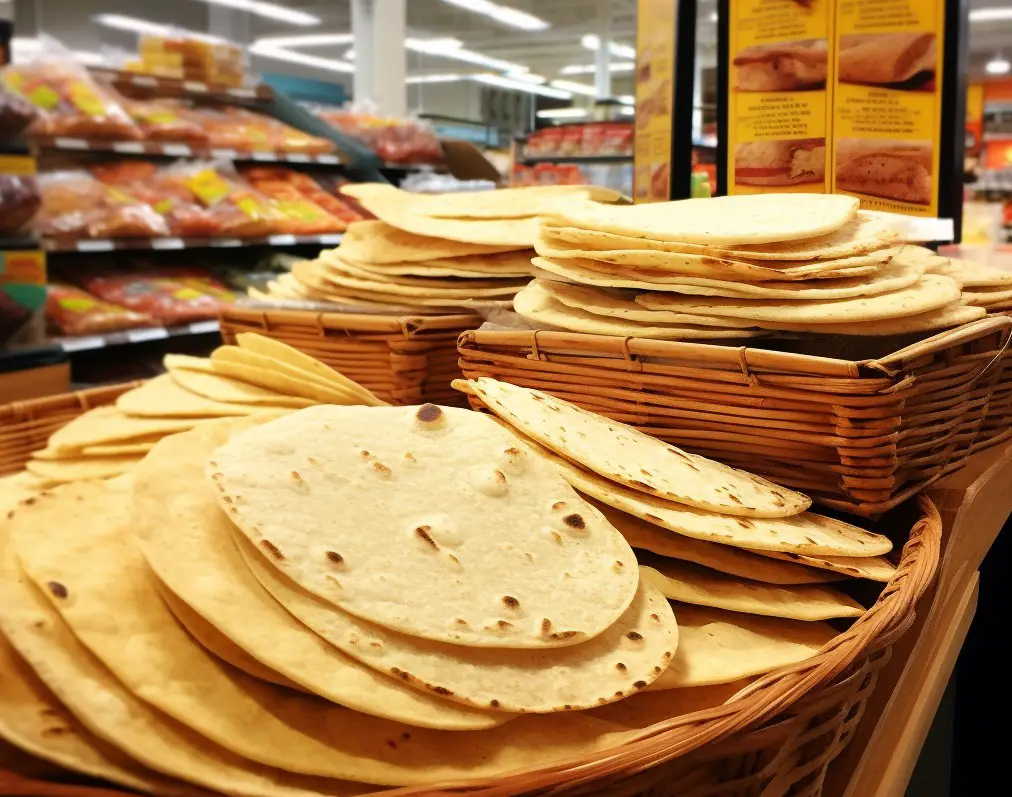 In the final dream sequence of an episode of The Simpsons which first aired on October 8, 1992, called “Homer the Heretic,” Homer Simpsons meets God. Near the end of this dream sequence, God says impatiently, “Now if you’ll excuse me, I have to appear on a tortilla in Mexico.” This, of course, was a funny line, and was based on cultural references to the possibility of this happening or that it had allegedly happened in the past. The lead singer of Nirvana, Kurt Cobain, wrote in his journal as a teenager, sometime in the early 1980s that, “I saw Jesus on a tortilla shell.” Maybe he meant a taco shell? People have often claimed to have seen miraculous images in common objects or ordinary places. Many of these instances can be easily explained away as cases of pareidolia, which is a psychological phenomenon where individuals perceive familiar patterns, such as faces, where none actually exist. Some instances, however, are harder to explain. Given this reference from The Simpsons from over 30 years ago, and the Kurt Cobain quote from even earlier, has the image of Jesus ever really appeared on a tortilla in Mexico? If so, how often does this occur? Let’s dive deep into this.
In the final dream sequence of an episode of The Simpsons which first aired on October 8, 1992, called “Homer the Heretic,” Homer Simpsons meets God. Near the end of this dream sequence, God says impatiently, “Now if you’ll excuse me, I have to appear on a tortilla in Mexico.” This, of course, was a funny line, and was based on cultural references to the possibility of this happening or that it had allegedly happened in the past. The lead singer of Nirvana, Kurt Cobain, wrote in his journal as a teenager, sometime in the early 1980s that, “I saw Jesus on a tortilla shell.” Maybe he meant a taco shell? People have often claimed to have seen miraculous images in common objects or ordinary places. Many of these instances can be easily explained away as cases of pareidolia, which is a psychological phenomenon where individuals perceive familiar patterns, such as faces, where none actually exist. Some instances, however, are harder to explain. Given this reference from The Simpsons from over 30 years ago, and the Kurt Cobain quote from even earlier, has the image of Jesus ever really appeared on a tortilla in Mexico? If so, how often does this occur? Let’s dive deep into this.
It’s an expectation that there would be a lot of information online about these miraculous tortilla appearances because it is so much a part of the lore that it almost seems like it must happen all the time. A basic internet search does not come up with dozens and dozens of astonishing and heartwarming stories of Jesus appearing on tortillas to the delight and amazement of the faithful. In fact, there is a big surprise when it comes to this phenomenon, something pretty unexpected: This whole genre of Jesus apparitions seems to take place more often on the American side of the border. The most famous instance of the face of Christ on a tortilla happened in New Mexico, America’s 47th state – and this podcaster’s home state – and not Old Mexico. It is interesting to note that the most famous sighting of Jesus on a tortilla in Old Mexico – and perhaps the first documented sighting ever – only happened in the year 2015.
In the town of Tlalixtac de Cabrera, Oaxaca, Enendina Mendoza was making tortillas to sear into tostadas in order to prepare tlayudas. Tlayudas are a traditional Oaxacan dish which uses a partially toasted or fried corn tortilla which is topped with refried beans, shredded meat, lettuce or cabbage, white cheese and salsa. A tlayuda is reminiscent of an Indian or Navajo taco found in the cuisine of the American Southwest. While Mendoza was searing her tortillas, she noticed that one wasn’t searing as well as expected. She lifted it up to reveal the face of Jesus burned into it. According to 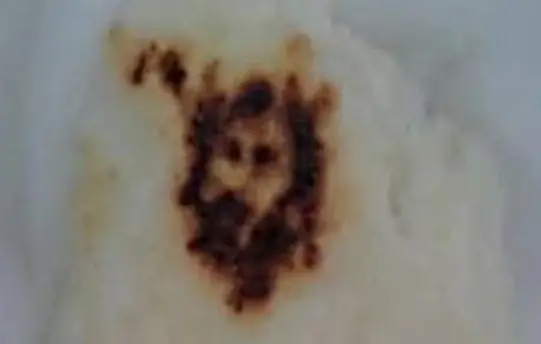 Enendina Mendoza, she had just argued with her sister that morning about whether they would be attending the town’s annual Fiesta de San Guillermo on June 25th. Her sister wanted to go and Enendina did not. When Enendina told her sister about the tortilla, they both agreed that this was a sign from above that the whole Mendoza family was to attend the San Guillermo festival. Enendina did not eat the tortilla but put it on her home altar next to an antique Virgin Mary statue and leaning up against a wood and glass nicho containing the Baby Jesus. The Mendoza home did draw some curious people initially, but the family did not allow their residence to become a pilgrimage site or tourist attraction. It is unknown if the Mendozas of Tlalixtac de Cabrera still have the tortilla. This specific incident does not seem to have any references online after the year 2016. In fact, the whole idea of “Jesus appearing on a tortilla in Mexico” seems to dead-end with Enendina Mendoza’s tlayuda miracle.
Enendina Mendoza, she had just argued with her sister that morning about whether they would be attending the town’s annual Fiesta de San Guillermo on June 25th. Her sister wanted to go and Enendina did not. When Enendina told her sister about the tortilla, they both agreed that this was a sign from above that the whole Mendoza family was to attend the San Guillermo festival. Enendina did not eat the tortilla but put it on her home altar next to an antique Virgin Mary statue and leaning up against a wood and glass nicho containing the Baby Jesus. The Mendoza home did draw some curious people initially, but the family did not allow their residence to become a pilgrimage site or tourist attraction. It is unknown if the Mendozas of Tlalixtac de Cabrera still have the tortilla. This specific incident does not seem to have any references online after the year 2016. In fact, the whole idea of “Jesus appearing on a tortilla in Mexico” seems to dead-end with Enendina Mendoza’s tlayuda miracle.
There is only a vague reference with no supporting citations to an incident at a bakery in Tlaquepaque, a suburb of Guadalajara. Blog writer Larry Lambert writes this in his April 5, 2017 post titled: “Worshipping a Tortilla”: “I’ve heard of riots and injuries at a bakery in Tlaquepaque (a subset of Guadalajara) in the run up to the holy week, as people jostled each other to have the opportunity to gaze at a tortilla that somebody placed at a shrine set up inside of a bakery.” Who knows if this was a rumor or something the blog author read about in an obscure local newspaper, but there are no other references to this supposed disruptive sighting, and the “Jesus appeared on a tortilla in Mexico” trail seems to go completely cold with the few sentences mentioning the Tlaquepaque bakery. Lambert also writes in his post, “I learned that Jesus appears on tortillas in Mexico with some regularity at Easter.” But where are the stories? Where is the evidence to support this claim? It sounds like a good story, though.
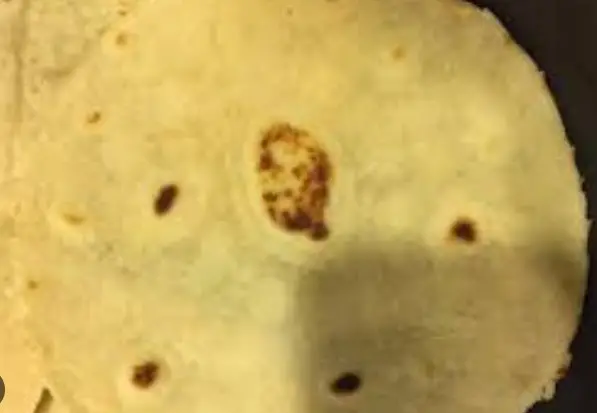 Going back in time, and crossing the border, in December of 2014 a man from Austin, Texas, named Andrew Key saw the face of Jesus in a tortilla he got as one in a batch from a friend. It made it on Local 12 News in Austin and then the story fell off the radar. No one knows what happened to the tortilla and what Key did with it.
Going back in time, and crossing the border, in December of 2014 a man from Austin, Texas, named Andrew Key saw the face of Jesus in a tortilla he got as one in a batch from a friend. It made it on Local 12 News in Austin and then the story fell off the radar. No one knows what happened to the tortilla and what Key did with it.
On May 18, 2011, Annette Escamilla of Corpus Christi, Texas, made her daily lot of flour tortillas for her family. According to Escamilla in a very emotional interview with a local news channel, her son woke her up at 4:15 the next morning to show her the face of Jesus burned into the second-to-last tortilla of the stack she made the night before. When asked what this image on the tortilla meant, the interviewer prompted Annette Escamilla and wondered if it was a sign or a blessing. Escamilla responded by saying, “I see it all different ways.” Again, a deep search of the internet shows no end to this story. What happened to the tortilla? Does the family still have it after all these years?
The whole notion of “Jesus appearing on a tortilla in Mexico” must have originated with the story which took place in the 47th state of the United States – New Mexico – briefly mentioned earlier. The story of the Rubio family of Lake Arthur, New Mexico gained worldwide attention and drew tens of thousands of pilgrims and curiosity-seekers from around the world. This event happened in October of 1977 and remains the most famous of all the alleged Jesus/tortilla apparitions.
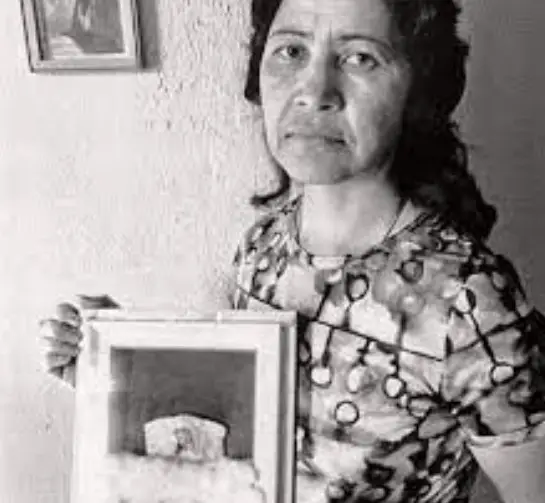 On that October morning, María Rubio was preparing food for the day, including making her own homemade tortillas as she usually did. On one of the tortillas, she noticed a strange burn mark and immediately called her 17-year-old daughter Rosy to come into the kitchen. Rosy verified what María thought she had seen: the face of Christ, with crown of thorns and everything, looking back at her from the warm, freshly made flour tortilla. María was born in the town of Ojinaga, Chihuahua, right across the border from Presidio, Texas in 1940, and her Catholic faith ran deep. She moved to southeastern New Mexico as a girl and she and her husband Eduardo eventually settled in the agricultural town of Lake Arthur, located just 30 miles south of New Mexico’s famous city of Roswell. On that fateful October morning, María woke up Eduardo to show him the tortilla and he didn’t have the same awestruck reaction as she and their daughter did. Eduardo thought it was a bad omen and felt that no good could come of this. Rosy went off to school and the Rubios cut out the face of Jesus, wrapped that part of the tortilla in a napkin and took the image to the local Catholic priest. The old priest was skeptical, but blessed the piece of the tortilla, nonetheless. While the Rubios were receiving their blessing, there were people at the church who went over to them to see what was going on. Those present became instant believers. Soon, word spread throughout the town of the miracle on the tortilla. By the time Rosy came home from school that day, dozens of people were at her house, scrutinizing the image, kneeling before it, and asking God for miracles in their own lives. Within a week, reporters from Roswell started visiting the Rubio home and by that time there was a line outside the Rubio’s small green-stucco home that was over 100 people deep. The Rubios set up a guest book, and by the end of the year, just within the period of three months, the guest book had over 6,000 signatures in it. The family did not charge admission to see the holy tortilla, nor did they make money off this in any other way. People showed up knocking at their door early in the morning and late at night, and María turned no one away. The next year, 1978, people came from all over the US and some even from Europe to see the tortilla, and major wire services like the Associated Press and United Press International sent reporters to cover the story. By the end of the 1970s the Rubios had gotten solid international attention. The humble family was overwhelmed. María started to see the apparition as a curse more than a blessing as her
On that October morning, María Rubio was preparing food for the day, including making her own homemade tortillas as she usually did. On one of the tortillas, she noticed a strange burn mark and immediately called her 17-year-old daughter Rosy to come into the kitchen. Rosy verified what María thought she had seen: the face of Christ, with crown of thorns and everything, looking back at her from the warm, freshly made flour tortilla. María was born in the town of Ojinaga, Chihuahua, right across the border from Presidio, Texas in 1940, and her Catholic faith ran deep. She moved to southeastern New Mexico as a girl and she and her husband Eduardo eventually settled in the agricultural town of Lake Arthur, located just 30 miles south of New Mexico’s famous city of Roswell. On that fateful October morning, María woke up Eduardo to show him the tortilla and he didn’t have the same awestruck reaction as she and their daughter did. Eduardo thought it was a bad omen and felt that no good could come of this. Rosy went off to school and the Rubios cut out the face of Jesus, wrapped that part of the tortilla in a napkin and took the image to the local Catholic priest. The old priest was skeptical, but blessed the piece of the tortilla, nonetheless. While the Rubios were receiving their blessing, there were people at the church who went over to them to see what was going on. Those present became instant believers. Soon, word spread throughout the town of the miracle on the tortilla. By the time Rosy came home from school that day, dozens of people were at her house, scrutinizing the image, kneeling before it, and asking God for miracles in their own lives. Within a week, reporters from Roswell started visiting the Rubio home and by that time there was a line outside the Rubio’s small green-stucco home that was over 100 people deep. The Rubios set up a guest book, and by the end of the year, just within the period of three months, the guest book had over 6,000 signatures in it. The family did not charge admission to see the holy tortilla, nor did they make money off this in any other way. People showed up knocking at their door early in the morning and late at night, and María turned no one away. The next year, 1978, people came from all over the US and some even from Europe to see the tortilla, and major wire services like the Associated Press and United Press International sent reporters to cover the story. By the end of the 1970s the Rubios had gotten solid international attention. The humble family was overwhelmed. María started to see the apparition as a curse more than a blessing as her 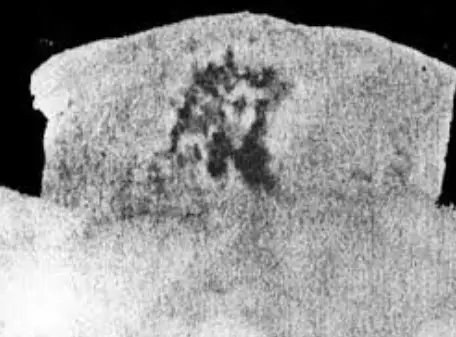 life became complicated and exhausting. Throughout the 1980s the Rubio home received a steady stream of visitors, and locals donated materials and labor to build a shrine to the tortilla outside the house so that the family would not be disturbed by sheer numbers of people coming in and out of their home. An added aside to the miracle is something Rosy Rubio shared with a reporter: After 3 or 4 days a fresh tortilla, if not eaten, becomes moldy. After many years, this special tortilla did not have one bit of mold on it. Skeptics claimed that this was easy to explain. Within a few days of snipping out the part of the tortilla with the face on it, María Rubio put it in a sealed glass frame on top of cotton balls to make it look like the image was floating on clouds. The cotton balls served to absorb any moisture sealed in the frame with the tortilla, thus preventing mold from growing. The Rubios were little unaware that their whole experience was being ridiculed by much of the people across the US who had heard their story. In 1994, María and Rosy appeared on the Donahue show. At the beginning of the show, when Phil Donahue mentioned that the face of Jesus had appeared on a tortilla, the crowd chuckled. The show had onstage a professional magician and debunker and some members of the audience were hostile to the idea that what happened in Lake Arthur, New Mexico was anything other than a clever hoax. After that experience, María vowed never to do another television interview, but when the Oprah Winfrey Show called, Rosy was on a plane to Chicago to be on the show. In that episode, Oprah said, “I just don’t know why Jesus would want to be on a tortilla,” and the crowd broke out in deafening laughter. That would be the last time the Rubios would participate in such high-profile public ridicule.
life became complicated and exhausting. Throughout the 1980s the Rubio home received a steady stream of visitors, and locals donated materials and labor to build a shrine to the tortilla outside the house so that the family would not be disturbed by sheer numbers of people coming in and out of their home. An added aside to the miracle is something Rosy Rubio shared with a reporter: After 3 or 4 days a fresh tortilla, if not eaten, becomes moldy. After many years, this special tortilla did not have one bit of mold on it. Skeptics claimed that this was easy to explain. Within a few days of snipping out the part of the tortilla with the face on it, María Rubio put it in a sealed glass frame on top of cotton balls to make it look like the image was floating on clouds. The cotton balls served to absorb any moisture sealed in the frame with the tortilla, thus preventing mold from growing. The Rubios were little unaware that their whole experience was being ridiculed by much of the people across the US who had heard their story. In 1994, María and Rosy appeared on the Donahue show. At the beginning of the show, when Phil Donahue mentioned that the face of Jesus had appeared on a tortilla, the crowd chuckled. The show had onstage a professional magician and debunker and some members of the audience were hostile to the idea that what happened in Lake Arthur, New Mexico was anything other than a clever hoax. After that experience, María vowed never to do another television interview, but when the Oprah Winfrey Show called, Rosy was on a plane to Chicago to be on the show. In that episode, Oprah said, “I just don’t know why Jesus would want to be on a tortilla,” and the crowd broke out in deafening laughter. That would be the last time the Rubios would participate in such high-profile public ridicule.
By the mid-1990s, and definitely after the Oprah show, the idea of “Jesus appearing on a tortilla” became somewhat of a pre-Internet meme and was solidly fixed into America’s pop culture. The fact that the big story that was responsible for this meme didn’t happen in Mexico didn’t seem to matter. Many Americans at the time had associated tortillas with Mexico and so went the meme. So, if you ever visit Mexico, don’t bother checking your tortillas because Jesus appearing on them doesn’t happen as frequently as one might think.
REFERENCES
Levin, Josh. “Jesus on a Tortilla.” In Slate, 17 nov 2021 (online version)
Local 12 News Austin
Larry Lambert’s “Virtual Mirage” blog.
